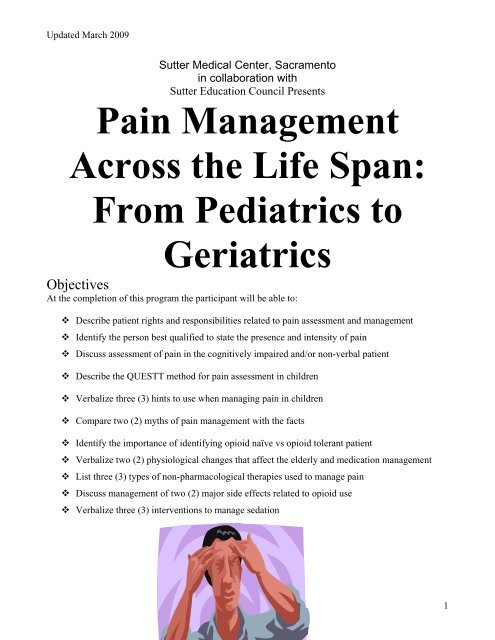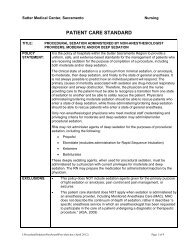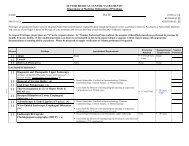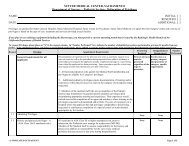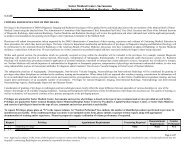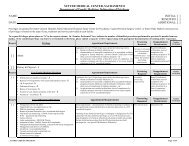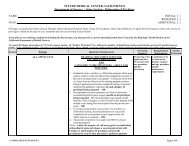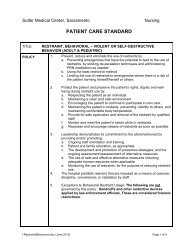Introduction to Pain Management - Sutter Medical Center
Introduction to Pain Management - Sutter Medical Center
Introduction to Pain Management - Sutter Medical Center
Create successful ePaper yourself
Turn your PDF publications into a flip-book with our unique Google optimized e-Paper software.
Updated March 2009<br />
<strong>Sutter</strong> <strong>Medical</strong> <strong>Center</strong>, Sacramen<strong>to</strong><br />
in collaboration with<br />
<strong>Sutter</strong> Education Council Presents<br />
<strong>Pain</strong> <strong>Management</strong><br />
Across the Life Span:<br />
From Pediatrics <strong>to</strong><br />
Geriatrics<br />
Objectives<br />
At the completion of this program the participant will be able <strong>to</strong>:<br />
Describe patient rights and responsibilities related <strong>to</strong> pain assessment and management<br />
Identify the person best qualified <strong>to</strong> state the presence and intensity of pain<br />
Discuss assessment of pain in the cognitively impaired and/or non-verbal patient<br />
Describe the QUESTT method for pain assessment in children<br />
Verbalize three (3) hints <strong>to</strong> use when managing pain in children<br />
Compare two (2) myths of pain management with the facts<br />
Identify the importance of identifying opioid naïve vs opioid <strong>to</strong>lerant patient<br />
Verbalize two (2) physiological changes that affect the elderly and medication management<br />
List three (3) types of non-pharmacological therapies used <strong>to</strong> manage pain<br />
Discuss management of two (2) major side effects related <strong>to</strong> opioid use<br />
Verbalize three (3) interventions <strong>to</strong> manage sedation<br />
1
Updated March 2009<br />
What is <strong>Pain</strong>?<br />
• <strong>Pain</strong> is an “unpleasant sensory and emotional experience associated with actual or potential tissue<br />
damage.” ISAP<br />
• “<strong>Pain</strong> is whatever the experiencing person says it is, existing whenever they say it does.” Margo<br />
McCaffrey<br />
Consequences of Untreated <strong>Pain</strong><br />
• “Unrelieved pain has negative physical and psychological consequences. Aggressive pain<br />
prevention and control that occurs before, during, and after surgery can yield both short-term and<br />
long-term benefits.” AHCPR Clinical Practice Guidelines- Acute <strong>Pain</strong> <strong>Management</strong><br />
• “Unrelieved pain has enormous physiological and psychological effects on the patient. The Joint<br />
Commission believes that effective management of pain is a crucial component of good care.<br />
Research clearly shows that unrelieved pain can slow recovery, create burdens for patients and their<br />
families, and increase costs <strong>to</strong> the health care system.” Dennis O’Leary, MD, President, JCAHO<br />
People Express Their<br />
<strong>Pain</strong> Differently<br />
• <strong>Pain</strong> is a personal experience; it is influenced by many personal fac<strong>to</strong>rs including emotional,<br />
spiritual and cultural issues.<br />
• People with the same medical condition, injury or surgery can have very different experiences<br />
with pain.<br />
• Some pain has no clear physical cause, but it is very real for the person who is suffering.<br />
• Assessing pain in children is difficult and requires a more global approach. (QUESTT)<br />
• There are many fac<strong>to</strong>rs that influence a child’s response <strong>to</strong> pain. These issues must be<br />
addressed <strong>to</strong> ensure that pain is managed properly in children.<br />
Preparation<br />
Cognitive level<br />
Age<br />
Parental anxiety<br />
level<br />
Child’s pain<br />
threshold<br />
Child’s<br />
response<br />
<strong>to</strong> pain<br />
Child’s anxiety<br />
level Reaction <strong>to</strong><br />
hospitalization<br />
Culture<br />
Developmental<br />
level<br />
Learned<br />
behaviors<br />
Gender<br />
Previous pain<br />
experience<br />
2
Updated March 2009<br />
• Children have many reasons as <strong>to</strong> why they deny, do not report, or are unwilling <strong>to</strong> display pain<br />
behaviors.<br />
Fear of the unknown<br />
Fear of needles (including fear of syringes without needles)<br />
Mental or physical capacity<br />
Severity or chronic state of their illness<br />
Emotional state<br />
Fear of pain itself and what it means.<br />
• Encourage family involvement in managing the child’s pain. Parents know the behaviors that<br />
their child will display when they are in pain.<br />
• Physiological responses may include:<br />
Skin flushing<br />
Diaphoresis<br />
Increased HR and/or increased RR and/or increased BP<br />
Drop in oxygen saturation<br />
Restlessness<br />
Dilated pupils<br />
• If there is uncertainty about the presence of pain, a diagnostic trial of medication is appropriate.<br />
• Developmental differences in pain expression include:<br />
(IT IS IMPORTANT TO INVOLVE THE PARENTS IN THE ASSESSMENT OF PAIN)<br />
Developmental<br />
Group<br />
Infants<br />
Toddlers<br />
Expressions of <strong>Pain</strong><br />
May demonstrate:<br />
• Body rigidity or thrashing which includes arching<br />
• Facial expression of pain (brows lowered and drawn <strong>to</strong>gether, eyes<br />
tightly closed, mouth open and squarish)<br />
• Intense crying<br />
• Are inconsolable<br />
• Draw knees <strong>to</strong> chest<br />
• Hypersensitivity<br />
• Poor feeding<br />
• Unable <strong>to</strong> sleep<br />
May demonstrate:<br />
• Intense crying or verbal aggression<br />
• Regress or withdraw<br />
• Physical resistance, pushing stimulus away<br />
• Guarding of painful areas<br />
• Unable <strong>to</strong> sleep<br />
3
Updated March 2009<br />
Preschoolers/<br />
Young<br />
Children<br />
School-Age<br />
Children<br />
Adolescents<br />
May:<br />
• Be verbal about intensity of their pain<br />
• Be very quiet and inactive while in pain<br />
• See pain as a punishment<br />
• Thrash arms and legs<br />
• Try <strong>to</strong> push stimulus away before it is applied<br />
• Need physical restraint<br />
• Cling <strong>to</strong> parent, nurse or significant person<br />
• Need emotional support<br />
• Understand rewarding<br />
• Be unable <strong>to</strong> sleep<br />
May:<br />
• Verbalize pain<br />
• Use pain measurement <strong>to</strong>ol<br />
• Be influenced by culture<br />
• Have nightmares related <strong>to</strong> their pain<br />
• Demonstrate “stalling” behaviors<br />
• Demonstrate muscular rigidity (clenched fists, white knuckles, gritted<br />
teeth, body stiffness, closed eyes, etc.)<br />
• May regress and demonstrate behaviors similar <strong>to</strong> preschoolers/young<br />
children<br />
• Be unable <strong>to</strong> sleep<br />
May:<br />
• Localize and verbalize pain using descrip<strong>to</strong>rs<br />
• Deny pain when peers are present<br />
• Change sleep and eating patterns<br />
• Be influenced by culture<br />
• Display regressive behaviors in the presence of family members<br />
• Demonstrate muscle tensing<br />
HINTS TO USE WHEN MANAGING PAIN IN CHILDREN<br />
Be honest about what will be painful, but reassuring as well. Trust is important.<br />
Explain procedures and sensations that the child will feel.<br />
Children do not like medical surprises, no one does.<br />
Tell the child what is about <strong>to</strong> happen, each step before the next.<br />
Preparing children for procedures will encourage cooperation most of the time.<br />
Utilize Child Life services whenever possible.<br />
Having a parent or loved one present during a painful treatment may be all that is<br />
needed. Utilize parents for comfort only.<br />
Encourage the expression of feelings and that it is okay <strong>to</strong> be afraid, cry, shout, etc.<br />
Only give a child a choice when one is present. (Which chair <strong>to</strong> sit in, etc.)<br />
Above all, believe children when they say they are in pain. <strong>Pain</strong> is a complex sensation<br />
that takes many fac<strong>to</strong>rs in<strong>to</strong> consideration and translates in<strong>to</strong> a physical expression.<br />
Children should not have <strong>to</strong> fight <strong>to</strong> be heard when they are in pain.<br />
4
Updated March 2009<br />
People of different cultures have different ways of<br />
expressing and dealing with pain.<br />
***These are general guidelines only. Responses <strong>to</strong> pain are uniquely individual***<br />
Black/African Americans: Expression of pain generally open and public but can vary. Fearful of<br />
addiction. Tip: Emphasize teaching re: positive aspects of pain management; pain scales helpful <strong>to</strong> rate<br />
discomfort levels.<br />
Chinese Americans: May not complain of pain. Some patients may use acupressure or acupuncture <strong>to</strong><br />
treat pain or illness. Tip: Be aware of non-verbal cues <strong>to</strong> assess pain. Offer pain meds instead of<br />
waiting for patient <strong>to</strong> ask.<br />
Filipinos: Can be s<strong>to</strong>ic. Fearful of addiction. Tip: Use numerical pain rating scale. Offer pain meds as<br />
ordered. Avoid IM injections if possible, prefer PO or IV.<br />
Hmong: Traditionally grew and used opium for its analgesic properties. Expect same relief from<br />
Western medicines. Medications readily accepted but instructions regarding dosage may not be<br />
followed; may continue <strong>to</strong> take more in an effort <strong>to</strong> find relief from pain. Tip: Encourage verbalization<br />
of proper medication use & side effects.<br />
Japanese Americans: Generally, symp<strong>to</strong>m complaints not offered by the patient. May not freely ask<br />
for medications <strong>to</strong> alleviate symp<strong>to</strong>ms & delay seeking assistance until symp<strong>to</strong>ms severe. Older<br />
generation fearful of addiction & may refuse meds. Tip: Offer pain medications, as ordered. Oral meds<br />
preferred <strong>to</strong> injections; may refuse rectal meds.<br />
Mexican Americans: Tend not <strong>to</strong> complain of pain. Prize inner control and self-endurance.<br />
Expression of pain socially more acceptable in women; some men fear expressing pain shows<br />
weakness and possible loss of respect. Tip: Assess pain by non-verbal cues.<br />
Russians: High pain threshold. Very s<strong>to</strong>ic and may not ask for pain medications. Tip: Encourage pain<br />
medications as ordered. Utilize numeric rating scale for measuring pain.<br />
Vietnamese: May be s<strong>to</strong>ic. Will not voluntarily request pain medication for fear of addiction and side<br />
effects. Tip: Offer pain meds as ordered. Prefer PO or IV. Observe pt’s facial expressions for<br />
indication of pain. Offer warm compress as needed.<br />
Acknowledgements: Culture & Nursing Care: A Pocket Guide. Eds. Juliene G. Lipson, Suzanne L. Dibble, and Pamela A. Minarik. School of Nursing,<br />
University of California, San Francisco. UCSF Nursing Press, 1996.<br />
5
Updated March 2009<br />
Patient Rights <strong>to</strong> <strong>Pain</strong> <strong>Management</strong><br />
All patients at <strong>Sutter</strong> <strong>Medical</strong> <strong>Center</strong> Sacramen<strong>to</strong> can expect:<br />
• To receive information about pain and pain relief measures<br />
from the health care team.<br />
• To be treated by concerned staff committed <strong>to</strong> pain prevention<br />
and management.<br />
• To have pain thoroughly assessed and promptly treated.<br />
• To participate actively in pain management decisions.<br />
• All patients, child or adult, have the right <strong>to</strong> appropriate pain assessment and management on a<br />
regular basis whether or not their parent/caregiver is at the bedside.<br />
Patient Responsibilities for <strong>Pain</strong> <strong>Management</strong><br />
All patients at <strong>Sutter</strong> <strong>Medical</strong> <strong>Center</strong> Sacramen<strong>to</strong> are expected <strong>to</strong>:<br />
• Ask their healthcare providers what <strong>to</strong> expect regarding pain and its management.<br />
• Discuss pain relief options with doc<strong>to</strong>rs and nurses.<br />
• Work with healthcare providers <strong>to</strong> develop pain management plans.<br />
• Report pain when it first begins.<br />
• Help healthcare providers measure pain at all stages of care.<br />
• Tell healthcare providers if pain is not relieved.<br />
<strong>Pain</strong> Assessment: The Fifth Vital Sign<br />
• Assembly Bill 791 (Thomson) was signed in<strong>to</strong> law by Governor Gray Davis on 9/15/99, effective<br />
1/1/00. Section 1254.7 was added <strong>to</strong> the Health & Safety Code (HSC) as part of this bill. HSC<br />
1254.7 reads:<br />
– It is the intent of the Legislature that pain be assessed and treated promptly, effectively, and for<br />
as long as the pain persists.<br />
– Every health facility licensed pursuant <strong>to</strong> this chapter shall, as a condition of licensure, include<br />
pain as an item <strong>to</strong> be assessed at the same time as vital signs are taken. The health facility shall<br />
insure that pain assessment is performed in a consistent manner that is appropriate <strong>to</strong> the patient.<br />
The pain assessment shall be noted in the patient’s chart in a manner consistent with other vital<br />
signs.<br />
6
Updated March 2009<br />
Who Assists With <strong>Pain</strong> <strong>Management</strong>?<br />
• Patients/Families & Caregivers<br />
• Physicians<br />
• Nurses<br />
• Rehabilitation Specialists<br />
• Clinical Social Workers<br />
• Case Managers<br />
• Pharmacists<br />
• Respira<strong>to</strong>ry Therapists<br />
• Chaplains<br />
The American Nurses Association (ANA) code makes it clear that RN’s have a duty <strong>to</strong> advocate<br />
what’s best for their patients. Fulfilling that duty requires that you question any order you believe <strong>to</strong> be<br />
below the standard of care, in violation of a hospital or employer policy or procedure or contrary <strong>to</strong> the<br />
patient’s best interests. Activate the chain of command if your patient’s pain needs are not being<br />
met.<br />
Myths and Misconceptions about <strong>Pain</strong><br />
1. Some pain is good for you.<br />
FALSE. Research has shown that pain is NOT good for the patient. It can cause<br />
depression and weaken the immune system.<br />
2. Newborns/Infants do not feel pain.<br />
That is NOT TRUE. Newborns feel the same amount of pain<br />
as any other age group. They just can’t tell us about their pain.<br />
3. Children <strong>to</strong>lerate pain better than adults.<br />
FALSE. Younger children experience a higher level of pain during procedures than older<br />
children. A child’s <strong>to</strong>lerance <strong>to</strong> pain increases with age. Repeated painful procedures often<br />
cause an increase in anxiety and perception of pain.<br />
4. It is unsafe <strong>to</strong> administer narcotics <strong>to</strong> children and the elderly.<br />
FALSE. The same medications are used <strong>to</strong> manage pain in children, adults and the elderly. In<br />
pediatrics, the doses are adjusted dependent upon the size and weight of the child.<br />
7
Updated March 2009<br />
5. The nurse or the doc<strong>to</strong>r is the best judge of the existence and severity of a patient’s pain.<br />
This is NOT TRUE.<br />
The patient is the best authority of his or her pain. The patient’s self report is the most<br />
reliable indica<strong>to</strong>r of pain.<br />
6. Visible signs, either physiologic or behavioral, always accompany pain and can be used <strong>to</strong><br />
verify its existence and severity.<br />
FALSE. Even with severe pain, periods of physiological and behavioral adaptation occur,<br />
leading <strong>to</strong> periods of minimal or no signs of pain. Lack of pain expression does not necessarily<br />
mean lack of pain.<br />
7. If a person does not ask for pain medication, then they don’t have pain.<br />
FALSE. Some cultures consider asking for pain medication a sign of<br />
weakness, however, if asked, they will admit they need pain relief. Some<br />
patients don’t want <strong>to</strong> be viewed as a “pest” or “complainer” and will not<br />
volunteer that information.<br />
8. Opioids produce limited analgesia effect.<br />
FALSE. The dose and the analgesic effect of mu agonist opioids have no<br />
ceiling effect. Examples of mu agonists include morphine, hydromorphone<br />
(Dilaudid), fentanyl, oxycodone, hydrocodone, codeine, methadone, and<br />
meperidine (Demerol). Mu agonists relieve pain by binding <strong>to</strong> the mu recep<strong>to</strong>r<br />
sites in the nervous system.<br />
9. There is an upper limit <strong>to</strong> the dose of opioid medications that can be given for pain relief.<br />
FALSE. Opioid pain relievers can be given in amounts needed <strong>to</strong> achieve pain relief, and may<br />
be combined with other medications <strong>to</strong> adjust for patient <strong>to</strong>lerance & side effects.<br />
10. Demerol (Meperidine) is the preferred drug of choice for post-operative pain.<br />
FALSE. Demerol is no longer preferred for the pain management of acute or chronic pain<br />
because of potential <strong>to</strong>xicity from accumulation of the metabolite, normeperidine. Half-life of<br />
normeperidine is 15-20hrs. Normeperidine is a CNS stimulant and can produce irritability,<br />
tremors, muscle twitching, jerking, agitation, and seizures (AHCPR1992). For maximum<br />
patient safety and effective pain control, consider these points regarding meperidine:<br />
– The meperidine dose should not exceed 1000mg/day in patients with normal renal<br />
function. The dose must be reduced in the elderly and patients with reduced renal function.<br />
– Meperidine use should be limited <strong>to</strong> less than 72hrs <strong>to</strong> avoid normeperidine accumulation.<br />
– Meperidine PCA is not recommended.<br />
8
Updated March 2009<br />
11. Analgesics are more effective when administered as needed (PRN) rather than around-theclock<br />
(ATC).<br />
False. Two basic principles of providing effective pain management are preventing pain and<br />
maintaining a pain rating that is satisfac<strong>to</strong>ry <strong>to</strong> the patient. These may require that the mainstay<br />
analgesic be administered on a scheduled ATC basis, rather than as needed, <strong>to</strong> maintain stable<br />
analgesic blood levels.<br />
12. People become addicted <strong>to</strong> pain medicine easily.<br />
FALSE. True addiction occurs RARELY when opioids are used correctly <strong>to</strong> relieve pain. Less<br />
than 1%. Addiction is often confused with <strong>to</strong>lerance and physical dependence.<br />
• Definitions:<br />
– Tolerance: An increased dose is required <strong>to</strong> reach the desired effect.<br />
– Physical dependence: A patient will show signs and symp<strong>to</strong>ms of withdrawal when in need<br />
of more medication.<br />
– Addiction: A psychological dependence on a drug with or without physical dependence.<br />
• Tolerance <strong>to</strong> opioids does develop, but this can and should be managed with dose adjustments.<br />
• Physical dependence may be managed with ATC medication weaning schedule.<br />
13. Old people are supposed <strong>to</strong> have pain.<br />
FALSE. <strong>Pain</strong> and aging do not go hand in hand. The elderly are at greater risk for many<br />
disorders that can cause pain, like arthritis. Quality of life is improved for the elderly if they are<br />
pain free.<br />
14. Patients should not receive pain medication until the cause of the pain is diagnosed.<br />
FALSE. Symp<strong>to</strong>matic relief of pain should be provided while investigation of cause<br />
proceeds.<br />
15. <strong>Pain</strong> medicine cannot really control pain.<br />
That is NOT TRUE. Good pain control can be achieved in over 90% of all patients with pain.<br />
16. It is easier <strong>to</strong> put up with the pain than the side effects that come from pain medicine.<br />
FALSE. The side effects of pain medications are well known and can be easily managed.<br />
17. Sleep equals pain relief<br />
FALSE. Patients may sleep as a means <strong>to</strong> cope with unrelieved pain.<br />
9
Updated March 2009<br />
Are Herbal supplements safe <strong>to</strong> take prior <strong>to</strong><br />
surgery?<br />
The available scientific literature suggests that certain herbs can prolong bleeding time, prolong the<br />
sedative effect of anesthesia, or cause fluctuations in blood pressure. Since the pharmacology of many<br />
herbs is not well documented, it may be wise <strong>to</strong> opt for the conservative stance of recommending<br />
against all herbal-product use in the 2-3 weeks preceding elective surgery. Healthcare professionals<br />
should routinely inquire about herb and supplement use when gathering a patient’s medical his<strong>to</strong>ry.<br />
Barriers <strong>to</strong> Proper <strong>Pain</strong> <strong>Management</strong><br />
• Inadequate training of healthcare providers in the recognition<br />
and management of pain in all populations.<br />
• Fear of addiction and over-dosage.<br />
• Fear of side effects from medications.<br />
• Fear of obscuring the diagnosis.<br />
• Reluctance of patients <strong>to</strong> complain of pain or demand pain treatment.<br />
• Cultural differences in pain expression.<br />
• Lack of standardized methods of communicating about pain e.g. the failure <strong>to</strong> provide pain<br />
scales on documentation forms.<br />
• The use of the IM route instead of PO, Rectal, IV or intraspinal.<br />
• Physician fears of legal problems and inconveniences with writing prescriptions for opioids.<br />
• Lack of institutional commitment <strong>to</strong> pain management practices.<br />
• Lack of attention <strong>to</strong> emotional and spiritual issues that may heighten the experience of pain.<br />
Ways <strong>to</strong> Improve <strong>Pain</strong> <strong>Management</strong><br />
• Consider pain the 5 th vital sign.<br />
• Use age/patient appropriate pain scales <strong>to</strong> measure the need for and response <strong>to</strong> analgesic<br />
therapy.<br />
• Develop a plan of care <strong>to</strong> manage pain consistently and document what works.<br />
10
Updated March 2009<br />
• Be aware of cultural differences in pain expression.<br />
• Develop pro<strong>to</strong>cols and <strong>to</strong>ols <strong>to</strong> prompt MD’s and nurses <strong>to</strong> assess & treat pain properly.<br />
• Ask every patient/parent/caregiver about pain.<br />
• Measure pain at regular intervals. Be proactive and not just reactive. Treat pain at a lower level<br />
before pain is out of control and higher doses are needed.<br />
• Anticipate predictable painful experiences and intervene accordingly. Prevention is better than<br />
treatment.<br />
• Use PO or IV meds whenever possible.<br />
• Utilize multiple modalities for pain control. Differing types of pain medications work <strong>to</strong>gether<br />
<strong>to</strong> provide better pain management. Use non-pharmacological methods along with medications.<br />
• Offer pain medication ATC, rather than waiting for the patient <strong>to</strong> ask.<br />
• Patient/parent/caregiver education.<br />
Assessing <strong>Pain</strong><br />
• The single most reliable indica<strong>to</strong>r of the existence and intensity of pain and any resultant<br />
distress is the patient’s self report!!!<br />
• There are many pain scale-rating <strong>to</strong>ols that can help your patients describe their pain.<br />
1. Talk <strong>to</strong> your Patient, Family &/or Caregiver<br />
• Getting a pain his<strong>to</strong>ry is the first step in pain management.<br />
• The his<strong>to</strong>ry must include opioid use: the terms opioid <strong>to</strong>lerant and opioid naïve are used <strong>to</strong><br />
distinguish between patients who have or have not been taking opioid drugs regularly.<br />
Those who have used opioids regularly for approximately 7 days or more are<br />
considered <strong>to</strong> be opioid <strong>to</strong>lerant.<br />
• A full assessment occurs on admission, at the beginning of each shift and if the patient’s<br />
pain status changes.<br />
• Remember <strong>to</strong> reassess pain whenever you obtain vital signs and whenever you<br />
intervene <strong>to</strong> evaluate the efficacy and the patient’s satisfaction with the treatment.<br />
11
Updated March 2009<br />
2. <strong>Pain</strong> Assessment<br />
A full pain assessment includes the following:<br />
Location- where does the pain start and <strong>to</strong> where does it radiate? (patient <strong>to</strong><br />
mark on a diagram or point <strong>to</strong> site)<br />
Intensity/Severity- use rating scales<br />
What provokes and/or relieves the pain?<br />
Quality and character of pain (use patient’s own words)<br />
Onset and duration of pain<br />
Patient’s comfort/function goal (on a 0-10 scale)<br />
When assessing children, it is not just about the pain score. Use the QUESTT (Baker<br />
and Wong, 1987) method <strong>to</strong> assess pain in children.<br />
Question the child about their pain.<br />
Use age appropriate pain rating scales.<br />
Evaluate behavior and physiologic changes.<br />
Secure parents’ involvement. Parents know their child’s pain behaviors.<br />
Take cause of pain in<strong>to</strong> account. Disease process, surgery, procedure, etc.<br />
Take action and evaluate results.<br />
FACT: In many elderly, the effects of Pharmacokinetics need <strong>to</strong> be considered when ordering<br />
medications.<br />
o In general, elderly tend <strong>to</strong> require lower doses of medications than<br />
younger patients.<br />
o Absorption is often irregular because of delayed transit time or<br />
malabsorption syndrome.<br />
o Elderly tend <strong>to</strong> have lower lean body mass.<br />
o Hepatic metabolism and renal clearance is also decreased.<br />
o In many elderly, the effects of opioids may be stronger & last longer, so<br />
the basic guideline for administration is <strong>to</strong> start low and go slow.<br />
FACT: In the Pediatric population, higher doses of medications (including pain medications)<br />
may be required per Kg <strong>to</strong> get the same effect due <strong>to</strong> increased metabolic demands. However,<br />
when the stimulus is removed, the child may then be at a higher risk for sedation leading <strong>to</strong><br />
respira<strong>to</strong>ry depression and will need close moni<strong>to</strong>ring.<br />
12
Updated March 2009<br />
3. Types of <strong>Pain</strong><br />
Acute <strong>Pain</strong><br />
• Relatively short-lived up <strong>to</strong> six months.<br />
• Cause is easily identified.<br />
• Onset is acute.<br />
• Physical response- increased BP, HR, respirations, nausea, etc.<br />
• Children may demonstrate agitation, fear reactions, grimacing, guarding of painful<br />
area, clenching teeth, anger, crying, moaning, withdrawal, etc.<br />
Chronic <strong>Pain</strong><br />
• Lasts longer than six months.<br />
• Onset is gradual.<br />
• Intensity – mild <strong>to</strong> severe.<br />
• Etiology- may be unknown.<br />
• Physical response- vital signs usually within normal limits for the patient.<br />
• Behavioral response- depression, irritability, social withdrawal, change in ADL’s.<br />
• Patients with chronic pain may report a higher baseline pain rating.<br />
Nociceptive <strong>Pain</strong> vs. Neuropathic <strong>Pain</strong><br />
Nocicepetive <strong>Pain</strong>: Normal process of stimuli that damages normal tissues or has the<br />
potential <strong>to</strong> do so if prolonged; usually responsive <strong>to</strong> non-opioids and/or opioids.<br />
Somatic <strong>Pain</strong>: most common physical type of pain.<br />
Skin<br />
Bones<br />
Muscles<br />
Ligaments<br />
Tendons<br />
Joints<br />
This includes arthritis, tendonitis, and most kinds of headaches, neck pain, and low back<br />
pain.<br />
Described as (quality and is well localized):<br />
Aching<br />
Throbbing<br />
Sore<br />
Knife-like<br />
Visceral <strong>Pain</strong>: Arises from visceral organs, such as GI tract and pancreas (contractions of<br />
hollow organs)<br />
Tumor involvement of the organ capsule that causes aching and fairly welllocalized<br />
pain.<br />
13
Updated March 2009<br />
Obstruction of hollow organ, which causes intermittent cramping and poorly<br />
localized pain.<br />
Described as (quality):<br />
Deep, cramping, boring sensation<br />
Includes:<br />
Abdominal cramping<br />
Brief periods when s<strong>to</strong>machs are upset<br />
Labor pain<br />
Irritable bowel syndrome (commonly chronic)<br />
Neuropathic <strong>Pain</strong>: Abnormal processing of sensory input by the peripheral or central nervous<br />
system; treatment usually includes adjuvant analgesics. Neuropathic pain requires attention<br />
<strong>to</strong> the underlying cause of pain.<br />
Centrally Generated <strong>Pain</strong>:<br />
Injury <strong>to</strong> either the peripheral or central nervous system.<br />
Phan<strong>to</strong>m pain – may reflect injury <strong>to</strong> the peripheral nervous system<br />
Burning pain below the level of a spinal cord lesion, reflects injury <strong>to</strong> the<br />
central nervous system.<br />
Associated with dysregulation of the au<strong>to</strong>nomic nervous system.<br />
Peripherally Generated <strong>Pain</strong>:<br />
<strong>Pain</strong>ful neuropathies: <strong>Pain</strong> is felt along the distribution of many peripheral nerves.<br />
Diabetic neuropathy<br />
Alcohol-nutritional neuropathy<br />
Those associated with Guillain-Barre syndrome<br />
<strong>Pain</strong>ful mononeuropathies: Usually associated with a known peripheral nerve injury and pain is<br />
felt at least partly along the distribution of the damaged nerve.<br />
Nerve root compression<br />
Nerve entrapment<br />
Trigeminal neuralgia<br />
Described as (quality):<br />
Burning<br />
Tingling<br />
Electric feeling (hitting funny bone)<br />
Includes:<br />
Carpal tunnel syndrome<br />
Various kinds of pinched nerves<br />
Neuropathy or nerve damage due <strong>to</strong> diabetes or a variety of other illnesses.<br />
Postherpetic neuralgia that follows shingles<br />
Herpes zoster<br />
14
Updated March 2009<br />
4. Additional information<br />
Some additional questions you may ask:<br />
• Have you had significant pain in the past?<br />
• If so, how did it affect you?<br />
• Has pain affected your work, social or family life? Does it interfere with your sleep,<br />
appetite, activity level, mood?<br />
Obtaining a his<strong>to</strong>ry of a patient’s previous experiences with pain will assist in assessing and<br />
managing their pain more effectively. Two forms are available and you may use both if<br />
necessary. This information is included in the Admission Data Base.<br />
<strong>Pain</strong> Experience His<strong>to</strong>ry<br />
Child form<br />
Parent form<br />
-Tell me what pain is.<br />
-What word(s) does your child use in regard <strong>to</strong> pain?<br />
-Tell me about the hurt you have had before.<br />
-Describe the pain experiences your child has had before.<br />
-Do you tell others when you hurt? If so, who?<br />
-Does your child tell you or others when he/she is hurting?<br />
-What do you do for yourself when you are hurting? -How do you know when your child is in pain?<br />
-What do you want others <strong>to</strong> do for you when you hurt? -How does your child usually react <strong>to</strong> pain?<br />
-What don’t you want others <strong>to</strong> do for you when you hurt? -What do you do for your child when he/she is hurting?<br />
-What helps the most <strong>to</strong> take your hurt away?<br />
-What does your child do for him/herself when he/she is hurting?<br />
-Is there anything special that you want me <strong>to</strong> know about -What works best <strong>to</strong> decrease or take away your child’s pain?<br />
you when you hurt? If yes, describe.<br />
-Is there anything special that you would like me <strong>to</strong> know about<br />
your child and pain? (If yes, describe)<br />
Hester NO, Barcus CS. Assessment and management of pain in children. Pediatric Nurs Update 1986;1:1-8.<br />
5. Words Used <strong>to</strong> Describe the Quality of <strong>Pain</strong><br />
Throbbing Stabbing Burning<br />
Aching Gnawing Sharp<br />
Dull Piercing Boring<br />
Crushing Numb Pulling<br />
Electrical Prickling Grabbing<br />
*** Identifying the quality of pain helps determine the type of pain the patient is experiencing<br />
i.e., acute, chronic or neuropathic. This information also helps determine what medication will<br />
be most effective for the specific type of pain***<br />
15
Updated March 2009<br />
<strong>Pain</strong> Scales – Numerical Rating<br />
• Numbers 0 – 10 along a straight line that denotes pain intensity<br />
• 0 = No <strong>Pain</strong><br />
• 10 = Worst <strong>Pain</strong> Possible<br />
• Most widely used for cognitively intact adults. May be used for children age 7 years<br />
and older.<br />
<strong>Pain</strong> Intensity Scale<br />
0-10 Numeric <strong>Pain</strong> Intensity Scale<br />
____________________________________________________________<br />
| | | | | | | | | | |<br />
0 1 2 3 4 5 6 7 8 9 10<br />
No Moderate Worst<br />
pain pain pain<br />
<strong>Pain</strong> Scales – Faces Rating<br />
• The Wong Baker Faces Scale is extremely helpful in assessing pain in children (ages three<br />
years and older), non-english speaking and mentally impaired adults.<br />
• The patient is asked <strong>to</strong> choose the facial expression that best depicts how they feel.<br />
• When using the <strong>to</strong>ol, it is imperative you use the explanation provided with the <strong>to</strong>ol.<br />
16
Updated March 2009<br />
FLACC SCALE<br />
(FACE, LEGS, ACTIVITY, CRY, CONSOLABILITY)<br />
The FLACC scale has been proven valid and reliable with infants and children up <strong>to</strong> 7 years of age.<br />
It can also be used in cognitively impaired teens in conjunction with the pain his<strong>to</strong>ry information.<br />
0<br />
1<br />
2<br />
FACE<br />
No particular expression<br />
or smile<br />
0<br />
Occasional grimace or<br />
frown, withdrawn,<br />
disinterested.<br />
1<br />
Frequent <strong>to</strong> constant<br />
frown, clinched jaw,<br />
quivering chin.<br />
2<br />
LEGS<br />
Normal position<br />
or<br />
Relaxed<br />
0<br />
Uneasy,<br />
Restless,<br />
Tense<br />
1<br />
Kicking,<br />
or<br />
Legs drawn up<br />
2<br />
ACTIVITY<br />
Lying quietly<br />
Normal position<br />
Moves easily<br />
0<br />
Squirming<br />
Shifting, back/forth<br />
Tense<br />
1<br />
Arched<br />
Rigid<br />
or<br />
Jerking<br />
2<br />
CRY<br />
No Cry<br />
(Awake or Asleep)<br />
0<br />
Moans or Whimpers<br />
Occasional Complaint<br />
1<br />
Crying Steadily<br />
Screams or Sobs<br />
Frequent Complaints<br />
2<br />
CONSOLABILITY<br />
Content<br />
Relaxed<br />
Reassured by occasional<br />
<strong>to</strong>uching, hugging, or<br />
`talking <strong>to</strong>.’<br />
Distractible<br />
Difficult <strong>to</strong> console or<br />
comfort.<br />
Instructions:<br />
1. Rate the patient in each of the 5 measurement categories.<br />
2. Observe for activity over 3-5 minutes. Have child turn and observe behavior.<br />
3. Add the numbers <strong>to</strong>gether.<br />
4. Document the pain score. This is a 0-10 pain scale. “0” being no pain and “10” being the worst pain.<br />
Guidelines for using the FLACC Behavioral <strong>Pain</strong> Scale<br />
Patients who are awake: Observe for at least 2-5 minutes. Observe legs and body uncovered. Reposition<br />
patient or observe activity, assess body for tenseness and <strong>to</strong>ne. Initiate consoling interventions if needed.<br />
Patients who are asleep: Observe for at least 5 minutes or longer. Observe body and legs uncovered. If possible<br />
reposition the patient. Touch the body and assess for tenseness and <strong>to</strong>ne.<br />
17
Updated March 2009<br />
Face<br />
Score 0 point if patient has a relaxed face, eye contact and interest in surroundings.<br />
Score 1 point if patient has a worried look <strong>to</strong> face, with eyebrows lowered, eyes<br />
partially closed, cheeks raised, mouth pursed.<br />
Score 2 points if patient has deep furrows in the forehead, with closed eyes, open<br />
mouth and deep lines around nose/lips.<br />
Legs<br />
Score 0 points if patient has usual <strong>to</strong>ne and motion <strong>to</strong> limbs (legs and arms)<br />
Score 1 point if patient has increased <strong>to</strong>ne, rigidity, tense, intermittent flexion/<br />
extension of limbs.<br />
Score 2 points if patient has hyper <strong>to</strong>nicity, legs pulled tight, exaggerated flexion/<br />
extension of limbs.<br />
Activity<br />
Score 0 points if patient moves easily and freely, normal activity/restrictions.<br />
Score 1 point if patient shifts positions, hesitant <strong>to</strong> move, guarding, tense <strong>to</strong>rso,<br />
pressure on body part.<br />
Score 2 points if patient is in fixed position, rocking, side-<strong>to</strong>-side head movement,<br />
rubbing body part.<br />
Cry<br />
Score 0 points if patient has no cry/moan awake or asleep.<br />
Score 1 point if patient has occasional moans, cries, whimpers, or sighs.<br />
Score 2 points if patient has frequent/continuous moans, cries, or grunts.<br />
Consolability<br />
Score 0 points if patient is calm and does not require consoling<br />
Score 1 point if patient responds <strong>to</strong> comfort by <strong>to</strong>uch or talk in ½-1 minute.<br />
Score 2 points if patient requires constant comforting or unable <strong>to</strong> console.<br />
Whenever feasible, behavioral measurement of pain should be used in conjunction with self-report.<br />
When self-report is not possible, interpretation of pain behaviors and decision-making regarding<br />
treatment of pain requires careful consideration of the context in which the pain behaviors were<br />
observed.<br />
Each category is scored on the 0-2 scale, which results in a <strong>to</strong>tal score of 0-10.<br />
Assessment of Behavioral Score:<br />
0 = Relaxed and comfortable 1-3 = Mild discomfort<br />
4-6 = Moderate pain 7-10 = Severe discomfort/pain<br />
18
Updated March 2009<br />
Assessment of <strong>Pain</strong> in the Cognitively Impaired<br />
and/or Non-Verbal Patient<br />
No single pain assessment instrument has been shown <strong>to</strong> effectively detect pain in this population. An<br />
attempt should always be made <strong>to</strong> have the patient self-report their pain. If unable, note presence of<br />
pathology or painful condition or procedure and treat for pain accordingly.<br />
Assess for presence of behaviors that may indicate pain (“pain signature”):<br />
Facial grimaces<br />
Bracing<br />
Guarding<br />
Rubbing<br />
Restlessness<br />
Tension<br />
Decreased appetite<br />
Negative or repetitive vocalizations<br />
Motioning for assistance<br />
Hitting<br />
Anxiety<br />
Sighing<br />
Insomnia<br />
Sadness or crying<br />
An analgesic trial should be implemented in patients who demonstrate pain behavior(s) or who have<br />
underlying painful pathology. Note a decrease in intensity of the behavior(s) <strong>to</strong> help confirm the<br />
presence of pain & response <strong>to</strong> treatment. Adjust the treatment plan as needed e.g., increase in<br />
analgesic dose or addition of analgesics if a behavior increases.<br />
Setting a Comfort/Function Goal<br />
• Ask the patient <strong>to</strong> identify a comfort/function goal. The comfort/function goal is a pain rating<br />
(0-10) that would be acceptable or satisfac<strong>to</strong>ry <strong>to</strong> the patient.<br />
• Satisfac<strong>to</strong>ry pain relief is a pain rating that is not distressing (i.e., noticeable but not<br />
bothersome).<br />
• The comfort/function goal allows a patient <strong>to</strong> participate in activities (turning, using an<br />
incentive spirometer, getting out of bed) and not be out of control with their pain.<br />
• Any pain above the patient’s comfort goal must be treated.<br />
• If the patient identifies a comfort/function goal that is unrealistic (for example, 0-1) re-educate<br />
and negotiate an acceptable and realistic comfort/function goal.<br />
• Research suggest that on the 0-10 pain rating scale, sustained pain ratings of 4 or above may<br />
result in delayed tissue healing, depressed immune system response and contribute <strong>to</strong><br />
prolonged hospital stays.<br />
• It is impractical <strong>to</strong> ask about a comfort/function goal for infants and children under the age of 4<br />
years so comfort should be based on a goal that will allow the child <strong>to</strong> be moved or held<br />
without increased distress.<br />
19
Updated March 2009<br />
Treating <strong>Pain</strong><br />
• 90% of all patients experiencing pain can be easily treated with medications and other<br />
therapies.<br />
• Some estimates state 50% of patients experiencing pain do not get relief.<br />
• Generally, any pain rated at 3/10 or greater indicates the need for pain management.<br />
• Remember early treatment with lower doses can prevent many side effects.<br />
• Tylenol is frequently used for the treatment of pain but is not a benign drug. Moni<strong>to</strong>r the<br />
<strong>to</strong>tal amount of drug used especially if other medication has Tylenol as an ingredient.<br />
Educate patient/parent/caregiver as well.<br />
FACT: Assume the presence of pain in patients who are unable <strong>to</strong> provide self-report using a pain<br />
rating scale or <strong>to</strong> fully respond with behaviors indicative of pain. Included in this category are patients<br />
during the immediate post-op period, critically ill sedated or chemically paralyzed patients, ventilated<br />
patients, non-responsive trauma patients, coma<strong>to</strong>se patients, “locked in” patients, and cata<strong>to</strong>nic &<br />
sedated patients undergoing painful procedures.<br />
Medications Can Help Manage <strong>Pain</strong><br />
Types of Medications<br />
Non-opioids<br />
NSAIDS<br />
Acetaminophen<br />
Opioids<br />
Morphine<br />
Fentanyl<br />
Codeine<br />
Adjuvants<br />
Stimulants/Steroids<br />
Anticonvulsants<br />
Antidepressants<br />
Combine medication types including alternative methods <strong>to</strong> make<br />
sure that all pain measures are being used before calling MD. Less<br />
opioids will be needed when combinations are used thus reducing the<br />
risk of oversedation or respira<strong>to</strong>ry depression.<br />
20
Updated March 2009<br />
Use the Right Medication<br />
• Non-opioids are used <strong>to</strong> treat mild pain (1-4) and opioids are used <strong>to</strong> treat moderate (5-6) <strong>to</strong><br />
severe (7-10) pain.<br />
• Acetaminophen reduces pain and fever but not swelling.<br />
• The main concern with Acetaminophen is liver <strong>to</strong>xicity. Ensure that the <strong>to</strong>tal daily dosage<br />
doesn’t exceed 4,000 mg (2,400 mg for patients who have three or more alcoholic drinks daily).<br />
• The recommended dose of Acetaminophen in pediatrics is 10-15mg/kg every 4-6 hrs.<br />
• NSAIDs help reduce pain, swelling and fever. Used for bone pain <strong>to</strong>o.<br />
• EMLA cream is an effective <strong>to</strong>pical local anesthetic used in pediatrics (should be >1mos old)<br />
for IV starts, lab draws, and LPs.<br />
• Avoid Demerol use. Due <strong>to</strong> its relatively low potency, short duration of action and <strong>to</strong>xic<br />
metabolite, Demerol is a poor analgesic choice.<br />
• Avoid use of analgesic adjuvants such as Hydroxyzine (Vistaril) and Promethazine (Phenergan)<br />
for pain management. However, these medications may be useful for management of nausea.<br />
Opioids<br />
• Opioids are used <strong>to</strong> treat moderate <strong>to</strong> severe pain.<br />
• Promote use of Morphine and Hydromorphone (Dilaudid). Caution: Mix-ups between these<br />
two drugs are among the most common and serious errors that can occur involving two highalert<br />
drugs.<br />
• May be used for acute or chronic pain.<br />
• Safe and effective when used correctly.<br />
• Opioid naïve patients need <strong>to</strong> be moni<strong>to</strong>red more closely than opioid <strong>to</strong>lerant patients.<br />
• Routes of administration – PO, SQ, IV, IM, Transdermal, Rectal supposi<strong>to</strong>ries, PCA, and<br />
Intraspinal. (Try <strong>to</strong> avoid IM.)<br />
• Cause less long-term damage <strong>to</strong> body systems than from other drug groups.<br />
FACT: Mistakes with Opioid administration represent the largest number of medication-errorrelated<br />
sentinel events.<br />
JCAHO tracks sentinel events, which are defined as incidents that result in death or major<br />
permanent loss of function. From January 1995 through 2003, of 276 medication-error-related<br />
sentinel events in the JCAHO database, 21% involved opioids (Croteau, 2004). 98% of the<br />
opioid related events resulted in patient death.<br />
21
Updated March 2009<br />
Opioid Naïve / Opioid Tolerant<br />
The terms opioid <strong>to</strong>lerant and opioid naïve are used <strong>to</strong> distinguish between patients who have or have<br />
not been taking opioid drugs regularly. Most clinicians consider a patient who has NOT used opioids<br />
regularly for approximately 7 days or more <strong>to</strong> be opioid naïve.<br />
Why is it important <strong>to</strong> know whether my patient is Opioid Naïve or<br />
Opioid Tolerant?<br />
If the patient is opioid naïve, the first dose administered should be the LOWEST dose in the range. If<br />
the patient is opioid <strong>to</strong>lerant, or has received a recent dose with inadequate pain relief and <strong>to</strong>lerable<br />
side effects, a dose on the higher end of the range should be administered.<br />
Opioid Equianalgesia<br />
• The term equianalgesia means approximately equal analgesia and is used when referring <strong>to</strong><br />
the doses of various opioid analgesics that provide approximately the same pain relief.<br />
• An Equianalgesic Dose Chart provides a list of analgesics at doses, both PO and IV that are<br />
approximately equal <strong>to</strong> each other in their ability <strong>to</strong> provide pain relief. The opioids/doses<br />
are theoretically interchangeable.<br />
• The Equianalgesic Dose Chart is helpful when switching from one medication or route <strong>to</strong><br />
another.<br />
• Morphine 10mg IV is approx equal <strong>to</strong> Demerol 75mg IV and Dilaudid 1.5mg IV.<br />
<strong>Pain</strong> Medication Dosing<br />
• Promote the use of ATC (Around-the-clock) dosing of analgesics.<br />
• Encourage prescribing of a PRN (as needed) regimen for breakthrough pain.<br />
• Start with lowest range dose ordered and titrate based on need and patient assessment,<br />
including level of sedation and respira<strong>to</strong>ry rate (refer <strong>to</strong> Acute & Chronic <strong>Pain</strong> <strong>Management</strong><br />
Decision Tree, addendum 4, Pro<strong>to</strong>col for <strong>Pain</strong> <strong>Management</strong>)<br />
<strong>Management</strong> of Side Effects<br />
• Side effects should be reported promptly & treated.<br />
• Anticipate and assess for the side effects for the medication given.<br />
• Most opioid side effects diminish quickly when a stable dose is established.<br />
• Our goal – <strong>Pain</strong> Prevention- will be defeated if side effects cause a patient <strong>to</strong> discontinue,<br />
underdone, or take opioids sporadically.<br />
22
Updated March 2009<br />
Side Effects: Sedation<br />
• Sedation is an opioid side effect that often goes away as patients adjust <strong>to</strong> their medication,<br />
although it may require a temporary decrease in their dose.<br />
• Excessive sedation from opioids in the opioid-naïve patient may affect the patient’s<br />
ability <strong>to</strong> participate in the recovery process and may lead <strong>to</strong> opioid-induced respira<strong>to</strong>ry<br />
depression.<br />
Sedation Assessment Scale<br />
- Mild Sedation<br />
1=Restless, Agitated<br />
2=Cooperative, Aware<br />
- Mild Sedation<br />
3=Drowsy, but responds <strong>to</strong> verbal stimuli or single light <strong>to</strong>uch, able <strong>to</strong> follow simple commands (if could presedation)<br />
- Moderate Sedation<br />
4=Response <strong>to</strong> Stimulus (i.e., loud voice, vigorous <strong>to</strong>uch)<br />
- Deep Sedation<br />
5=Response <strong>to</strong> Noxious Stimulus (i.e., pain, suctioning)<br />
- Anesthesia<br />
6=Unarousable<br />
• Based on our “Pro<strong>to</strong>col For <strong>Pain</strong> <strong>Management</strong>”, reassessment of the patient must occur within<br />
15-30 minutes following IV administration (based on onset and peak of drug), 30 minutes<br />
following IM administration and 1 hour following oral/rectal administration or nonpharmacological<br />
intervention.<br />
• Level of sedation is <strong>to</strong> be assessed & documented prior <strong>to</strong> and following each<br />
pharmacological intervention on the 24 hour Patient Care Record.<br />
• Clinically significant opioid-induced respira<strong>to</strong>ry depression in at-risk patients (opioid-naïve<br />
elderly patients & infants < 6 months) can be prevented by careful opioid titration and<br />
moni<strong>to</strong>ring of sedation and respira<strong>to</strong>ry status.<br />
• Caution is recommended when administering muscle relaxants & anxiolytics due <strong>to</strong> increased<br />
risk of sedation and respira<strong>to</strong>ry depression. Prior <strong>to</strong> administering these drugs, obtain approval<br />
for their administration from the provider responsible for the pain management plan.<br />
23
Updated March 2009<br />
Also watch patients who are receiving sedating antihistamines, such as diphenhydramine<br />
and antiemetics such as phenergan & inapsine, because they produce sedation and<br />
increased risk of respira<strong>to</strong>ry depression.<br />
<strong>Management</strong> of Sedation & Respira<strong>to</strong>ry Depression<br />
• Most patients experience sedation at the beginning of opioid therapy and whenever the opioid<br />
dose is increased significantly (Coyle, Portenoy, 1996)<br />
• If left untreated, excessive sedation in an opioid-naïve patient can progress <strong>to</strong> opioid induced<br />
respira<strong>to</strong>ry depression.<br />
• Clinically significant respira<strong>to</strong>ry depression in opioid-naïve patients can be prevented by<br />
careful opioid titration and close nurse moni<strong>to</strong>ring of sedation and respira<strong>to</strong>ry status (Levy,<br />
1994: Pasero, McCaffery, 1994).<br />
• Prevention of clinically significant respira<strong>to</strong>ry depression involves decreasing the opioid dose<br />
when excessive sedation is detected.<br />
***The importance of moni<strong>to</strong>ring sedation <strong>to</strong> prevent<br />
clinically significant respira<strong>to</strong>ry depression cannot be<br />
overemphasized. As the American <strong>Pain</strong> Society (1992)<br />
states, “No patient has succumbed <strong>to</strong> (opioid-induced)<br />
respira<strong>to</strong>ry depression while awake”***<br />
Additional Side Effects<br />
• Constipation from opioids is <strong>to</strong> be expected. Routine use of laxatives and s<strong>to</strong>ol softeners help<br />
most people regain bowel function. Increase activity and fluid intake as well.<br />
• Nausea is a common side effect of opioid use. It often goes away on its own once patients<br />
adjust <strong>to</strong> their medication. Some anti-nausea drugs can help.<br />
• Itching is a side effect of opioids and the most common side effect of intraspinal opioids. Side<br />
effects such as itching are often inappropriately labeled as allergic reactions. True allergic<br />
reactions <strong>to</strong> opioids such as morphine are extremely rare as they are endogenous elements.<br />
Consult a pharmacist with questionable reactions.<br />
• If additional medications are used <strong>to</strong> treat side effects, make sure <strong>to</strong> moni<strong>to</strong>r the patient for<br />
complications such as increased sedation and respira<strong>to</strong>ry depression.<br />
24
Updated March 2009<br />
Non-Pharmacological Therapies<br />
• Massage, guided imagery, aromatherapy, and therapeutic <strong>to</strong>uch can help with relaxation<br />
and comfort.<br />
• Distraction techniques including music therapy, talking <strong>to</strong> others, reading a book, watching<br />
TV/movies & playing Nintendo/games are effective techniques <strong>to</strong> be used with children, as<br />
well as adults.<br />
• Spiritual practices such as meditation and prayer can help relieve anxiety.<br />
• Heat and cold therapy are used for muscle spasms, swelling and relaxation.<br />
• Acupuncture is widely used in Chinese medicine.<br />
• TENS uses a mild electrical current on the skin <strong>to</strong> block pain signals <strong>to</strong> the brain.<br />
• Exercise promotes strength and endorphin release.<br />
• Make sure that specific methods that work for the patient are noted on the plan of care.<br />
25
Updated March 2009<br />
PAIN ASSESSMENT & DOCUMENTATION IN A NUTSHELL<br />
1. Establish comfort/function goal on admission and every shift. Comfort/function goal =<br />
number at which patient states pain becomes acceptable.<br />
Be sure the admission database is completely filled out, including the section on pain.<br />
2. For pain assessment, ask the patient <strong>to</strong> describe their pain using the 0 – 10 pain rating scale<br />
(or scale specific <strong>to</strong> your patient population). Record on the flow sheet.<br />
Document pain level (0-10) prior <strong>to</strong> each intervention.<br />
3. If the patient is experiencing pain that exceeds the comfort/function goal, offer the patient<br />
pain relief options (medications, positioning, ice-pack, etc).<br />
4. If medication is the pain relief option selected for the patient, record the patient’s premedication<br />
sedation level (1-6) using sedation assessment scale.<br />
5. Provide the pain relief option the patient requests. This can be medication, repositioning,<br />
alternatives, etc. Record on the flow sheet. Medication administration must also be<br />
documented on the MAR.<br />
6. If medications are the pain option selected for the patient, record the patient’s postmedication<br />
sedation level using sedation assessment scale (1-6).<br />
7. Record the pain intervention on the flow sheet (Medication and/or non-pharmacological<br />
intervention).<br />
8. Evaluate for effectiveness, patient response and presence of side effects:<br />
• IV or PCA bolus – within 15-30 minutes (based on onset and peak of drug)<br />
• IM – within 30 minutes<br />
• PO/Rectal – within 1 hour<br />
• Non-pharmacological – within 1 hour<br />
9. Record the effectiveness of whatever intervention is chosen. This is the post-intervention<br />
pain level (0-10).<br />
26
Updated March 2009<br />
Teach your Patients about:<br />
• Their rights <strong>to</strong> adequate pain management.<br />
• How and when <strong>to</strong> discuss their pain with their healthcare providers.<br />
• How <strong>to</strong> use the age-appropriate pain rating scale.<br />
• How <strong>to</strong> set a comfort/function goal.<br />
• Treatment options available, both pharmacologic and non-pharmacologic.<br />
• Combining medications and comfort measures <strong>to</strong> provide the best pain management.<br />
• Potential side effects and their management.<br />
• Discharge plans concerning pain management.<br />
• Community Resources available.<br />
• Remember <strong>to</strong> utilize the Patient Education Materials that have been developed:<br />
• “Managing Your <strong>Pain</strong>: What You Need <strong>to</strong> Know”<br />
• Patient Controlled Analgesia (PCA)<br />
o These resources are available in Russian, Spanish & Hmong, and can be<br />
obtained through Central Services.<br />
What Have We Learned?<br />
• All patients have a right <strong>to</strong> be as pain free as possible.<br />
• The patient’s self-report is the most reliable indica<strong>to</strong>r of pain.<br />
• Many myths and barriers exist that interfere with proper pain management.<br />
• <strong>Pain</strong> should be assessed frequently, whenever vital signs are taken --remember <strong>Pain</strong> is the 5th<br />
Vital Sign.<br />
• If the patient has not achieved their comfort/function goal, further treatment including<br />
pharmacological and/or non-pharmacological interventions need <strong>to</strong> be utilized.<br />
27


